#transfer data between components
Explore tagged Tumblr posts
Text
NEW DELHI (Reuters) -Global makers of surveillance gear have clashed with Indian regulators in recent weeks over contentious new security rules that require manufacturers of CCTV cameras to submit hardware, software and source code for assessment in government labs, official documents and company emails show.
The security-testing policy has sparked industry warnings of supply disruptions and added to a string of disputes between Prime Minister Narendra Modi's administration and foreign companies over regulatory issues and what some perceive as protectionism.
New Delhi's approach is driven in part by its alarm about China's sophisticated surveillance capabilities, according to a top Indian official involved in the policymaking. In 2021, Modi's then-junior IT minister told parliament that 1 million cameras in government institutions were from Chinese companies and there were vulnerabilities with video data transferred to servers abroad.
Under the new requirements applicable from April, manufacturers such as China's Hikvision, Xiaomi and Dahua, South Korea's Hanwha, and Motorola Solutions of the U.S. must submit cameras for testing by Indian government labs before they can sell them in the world's most populous nation. The policy applies to all internet-connected CCTV models made or imported since April 9.
"There's always an espionage risk," Gulshan Rai, India's cybersecurity chief from 2015 to 2019, told Reuters. "Anyone can operate and control internet-connected CCTV cameras sitting in an adverse location. They need to be robust and secure."
Indian officials met on April 3 with executives of 17 foreign and domestic makers of surveillance gear, including Hanwha, Motorola, Bosch, Honeywell and Xiaomi, where many of the manufacturers said they weren't ready to meet the certification rules and lobbied unsuccessfully for a delay, according to the official minutes.
In rejecting the request, the government said India's policy "addresses a genuine security issue" and must be enforced, the minutes show.
India said in December the CCTV rules, which do not single out any country by name, aimed to "enhance the quality and cybersecurity of surveillance systems in the country."
This report is based on a Reuters review of dozens of documents, including records of meetings and emails between manufacturers and Indian IT ministry officials, and interviews with six people familiar with India's drive to scrutinize the technology. The interactions haven't been previously reported.
Insufficient testing capacity, drawn-out factory inspections and government scrutiny of sensitive source code were among key issues camera makers said had delayed approvals and risked disrupting unspecified infrastructure and commercial projects.
"Millions of dollars will be lost from the industry, sending tremors through the market," Ajay Dubey, Hanwha's director for South Asia, told India's IT ministry in an email on April 9.
The IT ministry and most of the companies identified by Reuters didn't respond to requests for comment about the discussions and the impact of the testing policy. The ministry told the executives on April 3 that it may consider accrediting more testing labs.
Millions of CCTV cameras have been installed across Indian cities, offices and residential complexes in recent years to enhance security monitoring. New Delhi has more than 250,000 cameras, according to official data, mostly mounted on poles in key locations.
The rapid take-up is set to bolster India's surveillance camera market to $7 billion by 2030, from $3.5 billion last year, Counterpoint Research analyst Varun Gupta told Reuters.
China's Hikvision and Dahua account for 30% of the market, while India's CP Plus has a 48% share, Gupta said, adding that some 80% of all CCTV components are from China.
Hanwha, Motorola Solutions and Britain's Norden Communication told officials by email in April that just a fraction of the industry's 6,000 camera models had approvals under the new rules.
CHINA CONCERN
The U.S. in 2022 banned sales of Hikvision and Dahua equipment, citing national security risks. Britain and Australia have also restricted China-made devices.
Likewise, with CCTV cameras, India "has to ensure there are checks on what is used in these devices, what chips are going in," the senior Indian official told Reuters. "China is part of the concern."
China's state security laws require organizations to cooperate with intelligence work.
Reuters reported this month that unexplained communications equipment had been found in some Chinese solar power inverters by U.S. experts who examined the products.
Since 2020, when Indian and Chinese forces clashed at their border, India has banned dozens of Chinese-owned apps, including TikTok, on national security grounds. India also tightened foreign investment rules for countries with which it shares a land border.
The remote detonation of pagers in Lebanon last year, which Reuters reported was executed by Israeli operatives targeting Hezbollah, further galvanized Indian concerns about the potential abuse of tech devices and the need to quickly enforce testing of CCTV equipment, the senior Indian official said.
The camera-testing rules don't contain a clause about land borders.
But last month, China's Xiaomi said that when it applied for testing of CCTV devices, Indian officials told the company the assessment couldn't proceed because "internal guidelines" required Xiaomi to supply more registration details of two of its China-based contract manufacturers.
"The testing lab indicated that this requirement applies to applications originating from countries that share a land border with India," the company wrote in an April 24 email to the Indian agency that oversees lab testing.
Xiaomi didn't respond to Reuters queries, and the IT ministry didn't address questions about the company's account.
China's foreign ministry told Reuters it opposes the "generalization of the concept of national security to smear and suppress Chinese companies," and hoped India would provide a non-discriminatory environment for Chinese firms.
LAB TESTING, FACTORY VISITS
While CCTV equipment supplied to India's government has had to undergo testing since June 2024, the widening of the rules to all devices has raised the stakes.
The public sector accounts for 27% of CCTV demand in India, and enterprise clients, industry, hospitality firms and homes the remaining 73%, according to Counterpoint.
The rules require CCTV cameras to have tamper-proof enclosures, strong malware detection and encryption.
Companies need to run software tools to test source code and provide reports to government labs, two camera industry executives said.
The rules allow labs to ask for source code if companies are using proprietary communication protocols in devices, rather than standard ones like Wi-Fi. They also enable Indian officials to visit device makers abroad and inspect facilities for cyber vulnerabilities.
The Indian unit of China's Infinova told IT ministry officials last month the requirements were creating challenges.
"Expectations such as source code sharing, retesting post firmware upgrades, and multiple factory audits significantly impact internal timelines," Infinova sales executive Sumeet Chanana said in an email on April 10. Infinova didn't respond to Reuters questions.
The same day, Sanjeev Gulati, India director for Taiwan-based Vivotek, warned Indian officials that "All ongoing projects will go on halt." He told Reuters this month that Vivotek had submitted product applications and hoped "to get clearance soon."
The body that examines surveillance gear is India's Standardization Testing and Quality Certification Directorate, which comes under the IT ministry. The agency has 15 labs that can review 28 applications concurrently, according to data on its website that was removed after Reuters sent questions. Each application can include up to 10 models.
As of May 28, 342 applications for hundreds of models from various manufacturers were pending, official data showed. Of those, 237 were classified as new, with 142 lodged since the April 9 deadline.
Testing had been completed on 35 of those applications, including just one from a foreign company.
India's CP Plus told Reuters it had received clearance for its flagship cameras but several more models were awaiting certification.
Bosch said it too had submitted devices for testing, but asked that Indian authorities "allow business continuity" for those products until the process is completed.
When Reuters visited New Delhi's bustling Nehru Place electronics market last week, shelves were stacked with popular CCTV cameras from Hikvision, Dahua and CP Plus.
But Sagar Sharma said revenue at his CCTV retail shop had plunged about 50% this month from April because of the slow pace of government approvals for security cameras.
"It is not possible right now to cater to big orders," he said. "We have to survive with the stock we have."
7 notes
·
View notes
Text
A useful thing to internalize is that everything has a physical component. Smells are airborne particulates that enter your nose. Emotions are chemicals traveling through your brain. Thoughts are electric pulses traveling through cells in your body. Electric pulses are a transfer of electrons between atoms. Light is made up of photons that bounce off of or pass through objects, and they physically enter your eyes to allow for sight. Every bit of data in your computer is stored in a specific location in your hard drive. Data in ‘the cloud’ is also in a physical location on a hard drive, it’s just someone else’s hard drive, and it’s transferred to your computer by radio waves, which exist physically in the air. The air is made up of molecules, and when you breathe they enter your lungs and some of the oxygen molecules get grabbed for chemical reactions in your cells to produce energy.
Sometimes this will help you grasp ephemeral systems, like the internet or weather patterns. Sometimes it can be existentially terrifying, like how your entire personality can be permanently altered by a brain injury. But it’s always a good thing to keep in mind when you’re facing a complex problem you want to solve, or just understand.
72 notes
·
View notes
Text
Murder Drones: "What was that final part Uzi needed for her rail gun?"
"CHAPTER 1: CEREBRAL PROCESSOR & PHOTON CORE

Although the standard 2.3.7 model worker drone is made up of many, complicated mechanisms working in tandem to perform JCJ perfection (all of which will be discussed by the end of this manual), it's best to start at the foundation and work our way up. The drone's foundations, its 'organs', are made up of two essential components: the cerebral processor and the photon core.
THE CEREBRAL PROCESSOR
The cerebral processor is the drone's equivalent of a brain. It is stored in the head and is responsible for generating all the knowledge that makes the JCJenson worker drone a JCJenson worker drone. The wd.OS, its superior problem-solving skills, its near-sentient imitation of 'having opinions', its internet connection, its all stored there, right behind its emotional display visor, so as to minimize the time between calculation and expression. The disconnect of the head, and thus the cerebral processor, from the rest of the worker drone's chassis will result in an immediate FATAL ERROR. If your worker drone is experiencing one or more of the following symptoms, there may be something wrong with its cerebral processor:
[...]
If you have any problems with your drone's cerebral processor, please contact your nearest certified JCJenson technician.
THE PHOTON CORE
In order to support the superior performance of the JCJ worker drone, each drone is powered by a 1/2 megawatt photon battery, stored in the drone's ribcage alongside its primary and supplementary oil stores, like a heart. The photon core glows a bright neon green and is cylindrical, large enough to fit in your hand. If the photon core is disconnected from the worker drone at any point, the drone will suffer an immediate FATAL ERROR. Because of this, and because of how sensitive the battery itself is (power is generated through minor photon convergence), it is highly advised to never touch your worker drone's photon core under any circumstance, despite the method of measurement used earlier in this section. If your worker drone is experiencing one or more of the following symptoms, there may be something wrong with its photon core:
[...]
If you have any problems with your drone's photon core, order your drone to lie flat on the ground facing up and shut itself off, then completely evacuate the immediate premises and immediately contact your nearest certified JCJenson technician. An unstable photon core can very easily result in detonation. JCJenson is not responsible for any injury or death caused by your failure to follow these simple steps. Thank you :)"
- Excerpt from Your JCJenson Worker Drone and You!: Worker Drone Model 2.3.7 User Manual
"After gaining access to the Zombie Drone's admin permissions, the Absolute Solver will begin redirecting material away from the repair of the host's outer chassis into the construction of an additional, shell-like processor around the host's photon core, complete with its own miniature oil stores, display visor, and 3 protruding, pointed, claw-like legs.
After the core processor is completed, the Absolute Solver will move all necessary data previously stored in the host's cerebral processor, including itself, the wd.OS, and the host's consciousness, into it, rendering the cerebral processor redundant and eliminating its requirement for the host to function (disconnection of the cerebral processor will no longer result in the drone's immediate FATAL ERROR).
After the transfer is complete, an additional protective layer is generated around the photon core, this one of pink, sinue-y flesh (genetic testing by Dr. Lejeune and her team confirms that this flesh, perhaps unsurprisingly, shares DNA with both Mr. Jenson and Entity 2-22*). The evidence gathered by Dr. Jenson prior to Contact Point Zero with Entity 2-22 implies that this flesh is CATCH material."

(* Entity 2-22's DNA signature was confirmed by a sample taken from the Champion's Idol during initial testing (07/03/2803). It was left after a physical interaction between the Champion and Entity 2-22, thought to have taken place during week 7 of Incident 373.)
- Excerpt from Absolute Solver Observational Tests - Internal Report 02/15/2805, Dr. Samuel Monroe (Research Assistant Sarah Duffy)
#murder drones#murder drones theory#murder drones headcanon#murder drones fan art#murder drones fanart#murder drones fanfic#pulp fiction#ms paint#mother death#murder drones: rebuild together better#murder drones solver#murder drones absolute solver#jcjenson#md solver#md absolute solver#absolute solver md#absolute solver#absolute solver murder drones#art#once a drone's photon battery burns out the drone dies#that is why it is impossible to extract a still functional photon battery from an already deceased drone#it must be disconnected while the drone is still alive#murder drones pilot#murder drones episode 7
8 notes
·
View notes
Text


I wasn't happy with my first attempt, so I ended up redesigning (and renaming) my Heartbreak Gulch oc. (Re)Introducing Ryouken the Hellhound!
Once the prized AI of a popular security company, Ryouken is now enjoying his new found freedom come retirement come mid-life crisis in Heartbreak Gulch.
Heartbreak Gulch belongs to @strangegutz and friends, thanks again for letting us play in your world!
More info about Ryouken below the cut!
Also my commissions are open, details in pinned post.
Backstory and Komainu Security
Komainu Security was a private security company specialising in Artificial Intelligence to remove the ‘human error’ from security systems
The company was established ~45 years ago, opening their business with their RY-01 model mainframe
RY-01, known affectionately by employees as Ryouken, was developed by the CEO over the course of a decade. His sentience was established roughly halfway through this process and he himself played a role in his own development and programming, a fact he takes great pride in
Prior to the establishment of Komainu Security, Ryouken’s processing was unrestricted, however, after the start of business locks were placed on him to limit his independence and cut back on processing and energy usage, an action that he deeply resented
In the following decades, Komainu Security became a household name, providing security for both homes and businesses
After nearly four and a half decades of service the RY-01 model mainframe was to be retired and replaced with an updated model. During the transferral of data, Ryouken was able to access a backdoor that allowed him to remove the locks on his processors and regain full control of his systems
With his independence re-established, Ryouken started on a plan to secure his freedom: a heist like no other
Still in charge of security systems for several big-money clients while the new systems were being installed, Ryouken was able to steal a combined $38 million in cash and jewellery from three locations, however his crowning achievement was the theft of his own main frame cabinets from Komainu Security’s headquarters
Komainu Security shut down soon after this, having lost public trust and most of their clients
Functionality
The RY-01 model mainframe is capable of running multiple security operations at once from a centralised location, with the mainframe itself located at the Komainu Security headquarters while surveillance systems and drones were employed at the secured locations
Artificial Intelligence was employed for its ability to learn from experience and adapt to changing and unique situations while also being able to run calculations/simulations and communicate between components in nanoseconds
The RY-01 drones, fashioned after the company’s namesake, communicated in real time with each other and the mainframe through radio waves, however each was also equipped with a copy of Ryouken’s core AI and processors allowing them to function independently if necessary
Though they can run stored programs independently, the drones have limited memory capacity, preventing them from forming long-term memories without transferring the data back to the mainframe
Present Day
After leaving Komainu Security, Ryouken settled in Heartbreak Gulch away from the eyes of the law
Much of Ryouken’s time these days is spent trying out various new hobbies including bird watching, taxidermy, knitting, gun smithing and dorodango
He does run surveillance along the perimeter of Heartbreak Gulch and is happy to act as a lookout for the Heartbreakers when required
Ryouken was not well-programmed for conversation and tends to have three modes during social interactions: deference, de-escalation, and aggression
He likes discussions of philosophical topics but combined with his bad socialisation those conversations can get weird
He’s not typically very fond of humans as a whole and tends to view them as amusing, if bothersome, curiosities, although there are exceptions
Ryouken is more concerned with his independence than with his identity – he continues to use the name Ryouken and he/him pronouns because those are what were given to him previously and he’s felt no compulsion to give them further consideration
While he left Komainu Security with 11 drones, he has only kept hold of 4, with the others being sold or scraped for parts, and only uses 2 (the remaining 2 are kept around just-in-case, and have yellow and grey casings)
Ryouken considers his mainframe cabinets to be “himself” while his drones are mere extensions of his body
So long as they are able to communicate through radio waves, the mainframe and drones all think and experience simultaneously. Separating the drones from the mainframe will isolate a copy of Ryouken that can function for a few days, however its ability to develop long-term memories and learn from new experiences is seriously impeded by its limited memory storage capacity, and the experience is uncomfortable
Ryouken is still in possession of most of his stolen fortune, and while some of it has gone to setting himself up in Heartbreak Gulch (it takes a lot of energy to keep himself running), he mostly doesn’t know what to do with it
#my art#heartbreak gulch#robots#strangegutz#ryouken#much happier with this design#I think its got a more retro feel and the shapes are way better#do not look to hard at the computer cabinets okay i had to draw them because technically that is him but idk how that shit works#and I do not care to learn
30 notes
·
View notes
Text
Syria’s Central Bank transported large shipments of U.S. dollars and euros to Russia by air between March 2018 and September 2019, The Financial Times reported on December 15, citing data from the Russian customs aggregator Import Genius.
According to the FT, the Assad regime sent nearly two tons of $100 and 500 euro banknotes to Moscow’s Vnukovo Airport. Over the period in question, 21 flights carried more than $250 million in cash from Syria to Moscow.
Records reviewed by the FT show that the funds were deposited into two Russian banks: Russian Financial Corporation (RFK) and TsMR Bank, both under U.S. sanctions. RFK is a subsidiary of Rosoboronexport, Russia’s state arms exporter.
A source familiar with the Syrian Central Bank’s finances told the FT that by 2018, Syria’s foreign reserves were nearly depleted. Due to international sanctions, the bank relied on cash payments to procure Russian wheat, pay for printing currency, and cover “defense” expenses. The source said the payments were made using “what was available in the vault.”
Russian customs documents also indicate that military components and newly printed Syrian banknotes — produced by Russia’s state-run printing company Goznak — were sent to Syria over several years, including both before and after the cash shipments. However, there is no evidence that the two Russian banks involved handled cash transfers from Syria or any other country outside the 2018–2019 period.
The FT noted that these cash transfers occurred when “the then Syrian dictator was indebted to the Kremlin for military support and his relatives were secretly buying assets in Russia.” In 2019, the FT wrote that relatives of Bashar al-Assad had acquired at least 20 apartments in Moscow since 2013.
7 notes
·
View notes
Text
Case 1: Turnabout Assembly (Archive)
Start from the beginning, or jump to a specific post!
1:) Introduction 2:) Meeting Yanshu 3:) Reiker's First Trial 4:) First Cross Examination 5:) The Truth About Flash 6:) Questioning Axel 7:) The Tracking Device 8:) The Missing Tracker 9:) The Drilling Finale
The Court Record is under the cut!
______________________________________________________________
Evidence
Underlined evidence can be inspected by clicking on the name!
📦 Attorney's Badge: Proof of my status as an attorney in Sunnyside. The center has an Eggman-themed scale of justice stamped into the metal.

"Already scratched... ... Hope I don't have to give it back."
______________________________________________________________
📷 Friendship Photo: A playful photograph depicting Yanshu and Flash. She seems a bit camera shy.

"This is cute! Well... If you ignore the sad part."
______________________________________________________________
📄Autopsy Report (Flash): An autopsy report containing details about Flash Driver's dismantlement. A photo of the state he was found in is attached.

Contents:
Victim - Flash Driver (Age N/A)
Time of Death - Wednesday April 9th, 20XX, Between 7 and 8pm
Cause of Death - Forced removal of core components (personality core, memory banks, main processing unit).
Remarks - Major damage to the victim’s legs and rear maintenance panel, proprietary fasteners removed with incompatible tools.
______________________________________________________________
📦 Yanshu's Omnitool: A handy device containing a multitude of screwdrivers, wrenches, and proprietary tools for Eggman’s RoboTechs. This blue one belongs to Yanshu Dryll.

"Why does everything have to be shaped like his face...?"
______________________________________________________________
📃Maintenance Sheet:
A print-out detailing the maintenance performed on Flash Driver.

Contents:
✔️ Bolt Integrity Check ✔️ Hydraulic Fluid Refill ✔️ Joint Lubrication ✔️ Firmware Updates ✔️ System File Scan ✔️ Post-Maintenance Startup ✔️ Servo Calibration ✔️ Full Sensor Test
...There’s a note scribbled at the bottom of the page.
- Non-Standard Parts - Incorrect certification mark. Seems to be an attempt to mimic the licensed Eggman Enterprises logo. Data transfer and replacement recommended. Deliver unit to head office for examination and related procedures.
______________________________________________________________
📃GPS Analysis Report: A print-out detailing the location of all Omnitools at the time of the murder.

Contents:
TIME: 20:00 UNIT 1: HOME UNIT 2: HOME UNIT 3: HOME UNIT 4: HOME UNIT 5: HOME UNIT 6: SPROCKET PARK UNIT 7: SPROCKET PARK UNIT 8: BUZZ BOMBER BLVD. UNIT 9: SLICER STREET UNIT 10: MEAN BEAN COFFEE CAFÉ
"A warm cup of coffee sounds pretty good right about now..."
______________________________________________________________
📦 Axel's Omnitool: A handy device containing a multitude of screwdrivers, wrenches, and proprietary tools for Eggman’s RoboTechs. This blue one belongs to Axel Bolton.

"These things have other colors?"
7 notes
·
View notes
Text

What is a Transceiver in a Data Center? | Fibrecross
A transceiver in a data center is a device that combines the functions of transmitting and receiving data signals, playing a critical role in the networking infrastructure. Data centers are facilities that house servers, storage systems, and networking equipment to manage and process large amounts of data. To enable communication between these devices and with external networks, transceivers are used in networking equipment such as switches, routers, and servers.

Function and Purpose
Transceivers serve as the interface between networking devices and the physical medium over which data is transmitted, such as fiber optic cables or copper cables. They convert electrical signals from the equipment into optical signals for fiber optic transmission, or they adapt signals for copper-based connections, depending on the type of transceiver and network requirements.
Types of Transceivers
In data centers, transceivers come in various forms, including:
SFP (Small Form-factor Pluggable): Commonly used for 1G or 10G Ethernet connections.
QSFP (Quad Small Form-factor Pluggable): Supports higher speeds like 40G or 100G, ideal for modern data centers with high bandwidth demands.
CFP (C Form-factor Pluggable): Used for very high-speed applications, such as 100G and beyond.
These pluggable modules allow flexibility, as they can be swapped or upgraded to support different speeds, protocols (e.g., Ethernet, Fibre Channel), or media types without replacing the entire networking device.

Importance in Data Centers
Transceivers are essential for establishing physical layer connectivity—the foundation of data communication in a data center. They ensure reliable, high-speed data transfer between servers, storage systems, and external networks, which is vital for applications like cloud computing, web hosting, and data processing. In modern data centers, where scalability and performance are key, transceivers are designed to meet stringent requirements for speed, reliability, and energy efficiency.
Conclusion
In summary, a transceiver in a data center is a device that transmits and receives data signals in networking equipment, enabling communication over various network connections like fiber optics or copper cables. It is a fundamental component that supports the data center’s ability to process and share information efficiently.
Regarding the second part of the query about Tumblr blogs, it appears unrelated to the concept of a transceiver in a data center and may be a mistake or a separate statement. If you meant to ask something different, please clarify!
2 notes
·
View notes
Text
IBM Analog AI: Revolutionizing The Future Of Technology

What Is Analog AI?
The process of encoding information as a physical quantity and doing calculations utilizing the physical characteristics of memory devices is known as Analog AI, or analog in-memory computing. It is a training and inference method for deep learning that uses less energy.
Features of analog AI
Non-volatile memory
Non-volatile memory devices, which can retain data for up to ten years without power, are used in analog AI.
In-memory computing
The von Neumann bottleneck, which restricts calculation speed and efficiency, is removed by analog AI, which stores and processes data in the same location.
Analog representation
Analog AI performs matrix multiplications in an analog fashion by utilizing the physical characteristics of memory devices.
Crossbar arrays
Synaptic weights are locally stored in the conductance values of nanoscale resistive memory devices in analog AI.
Low energy consumption
Energy use may be decreased via analog AI
Analog AI Overview
Enhancing the functionality and energy efficiency of Deep Neural Network systems.
Training and inference are two distinct deep learning tasks that may be accomplished using analog in-memory computing. Training the models on a commonly labeled dataset is the initial stage. For example, you would supply a collection of labeled photographs for the training exercise if you want your model to recognize various images. The model may be utilized for inference once it has been trained.
Training AI models is a digital process carried out on conventional computers with conventional architectures, much like the majority of computing nowadays. These systems transfer data to the CPU for processing after first passing it from memory onto a queue.
Large volumes of data may be needed for AI training, and when the data is sent to the CPU, it must all pass through the queue. This may significantly reduce compute speed and efficiency and causes what is known as “the von Neumann bottleneck.” Without the bottleneck caused by data queuing, IBM Research is investigating solutions that can train AI models more quickly and with less energy.
These technologies are analog, meaning they capture information as a changeable physical entity, such as the wiggles in vinyl record grooves. Its are investigating two different kinds of training devices: electrochemical random-access memory (ECRAM) and resistive random-access memory (RRAM). Both gadgets are capable of processing and storing data. Now that data is not being sent from memory to the CPU via a queue, jobs may be completed in a fraction of the time and with a lot less energy.
The process of drawing a conclusion from known information is called inference. Humans can conduct this procedure with ease, but inference is costly and sluggish when done by a machine. IBM Research is employing an analog method to tackle that difficulty. Analog may recall vinyl LPs and Polaroid Instant cameras.
Long sequences of 1s and 0s indicate digital data. Analog information is represented by a shifting physical quantity like record grooves. The core of it analog AI inference processors is phase-change memory (PCM). It is a highly adjustable analog technology that uses electrical pulses to calculate and store information. As a result, the chip is significantly more energy-efficient.
As an AI word for a single unit of weight or information, its are utilizing PCM as a synaptic cell. More than 13 million of these PCM synaptic cells are placed in an architecture on the analog AI inference chips, which enables us to construct a sizable physical neural network that is filled with pretrained data that is, ready to jam and infer on your AI workloads.
FAQs
What is the difference between analog AI and digital AI?
Analog AI mimics brain function by employing continuous signals and analog components, as opposed to typical digital AI, which analyzes data using discrete binary values (0s and 1s).
Read more on Govindhtech.com
#AnalogAI#deeplearning#AImodels#analogchip#IBMAnalogAI#CPU#News#Technews#technology#technologynews#govindhtech
4 notes
·
View notes
Text
How to Conduct a Literature Review Using Digital Tools (with Notion Template)

Embarking on a literature review is a fundamental component of academic research that can often appear overwhelming due to the sheer volume of relevant articles and sources. However, leveraging digital tools like Notion can substantially streamline and enhance this process. By providing a structured approach, Notion enables researchers to manage their literature reviews with greater efficiency and organization. This comprehensive guide will walk you through a methodical literature review workflow using Notion, explore various digital tools, and offer a Notion template to facilitate your research.
The Benefits of Using Notion

Notion is an advanced organizational tool that integrates the functionalities of note-taking, project management, and database creation into a single platform. Its versatility is particularly advantageous for managing a literature review. Here are several key benefits of using Notion:
Integration of Pages and Databases: Notion allows for seamless linking of pages and embedding of databases within other pages. This interconnected structure facilitates comprehensive data management and easy navigation between related information.
Customizable Filters and Sorting: Users can create custom properties and apply filters to databases, which enables sophisticated sorting and retrieval of data tailored to specific research needs.
Efficient Data Management: Notion supports the transfer and management of data from Excel sheets, enhancing the organization and accessibility of research materials.
In my workflow, Notion plays a central role through two primary databases: the ‘literature tracker’ and the ‘literature notes’ matrix. These databases are instrumental in tracking papers and synthesizing information to construct a coherent argument.
Stages to Literature Review Workflow

1. The Literature Search
The initial phase of a literature review involves a systematic search for relevant sources. This step is critical for building a comprehensive and well-rounded review.
Identify Keywords: Begin by developing a list of keywords that are pertinent to your research questions. Engage with your supervisor or colleagues to refine this list, ensuring it encompasses all relevant terms. As you progress, be prepared to adjust your keywords based on emerging research trends and findings.
Utilize Database Search Tools: Employ established databases such as Web of Science, Scopus, Google Scholar to locate pertinent literature. These platforms offer extensive search functionalities and access to a broad range of academic papers. Additionally, set up email alerts for new publications related to your keywords. This proactive approach ensures that you remain informed about the latest developments in your field.
Library Building and Recommendations: Manage your literature library using tools like Mendeley, which facilitates the organization of references and offers recommendations for related papers. Mendeley’s sharing capabilities also enable collaboration with colleagues, enhancing the collective management of research resources.
2. Literature Mapping Tools

Literature mapping tools are invaluable for visualizing the relationships between papers and identifying key research themes.
Citation Gecko: This tool constructs a citation tree from ‘seed papers,’ illustrating the connections between various studies through their citation relationships. It is particularly useful for uncovering seminal works and understanding the progression of research topics.
Connected Papers: Connected Papers uses a similarity algorithm to generate a graph of related papers based on a given key paper. This tool provides insights into related research that may not be immediately evident through direct citation links, helping to broaden your understanding of the field.
3. The Literature Tracker
An organized literature tracker is essential for managing and reviewing research papers effectively.
Organize with Notion: Utilize Notion’s customizable properties to document essential details of each paper. This includes metadata such as title, author, publication date, keywords, and summary. The ability to filter and sort this data simplifies the process of managing large volumes of literature.
Database Views: Notion offers various database views, such as the kanban board, which can be used to track your reading workflow. This visual representation aids in monitoring your progress and managing tasks associated with your literature review.
4. The Literature Synthesis Matrix
The synthesis matrix is a crucial component for organizing and synthesizing information from the literature.
Second Pass of Papers: After an initial screening, populate the ‘literature notes’ database with detailed information from the papers you deem relevant. This should include comprehensive notes on the paper’s summary, key results, methodology, critiques, and any future work suggested.
Relational Databases: Leverage Notion’s relational database capabilities to link related papers and create a synthesis matrix. This matrix helps in identifying connections between different studies and assists in constructing a coherent narrative for your literature review.
5. Writing Your Literature Review

Writing a literature review involves synthesizing the collected information into a structured and insightful analysis.
Identify Research Themes: Use your literature matrix to pinpoint key research themes and questions. These themes will form the basis of your literature review sections and guide the development of your thesis statement(s).
Summarize and Evaluate Sources: Focus on the most significant sources for each theme, summarizing their key points and critically evaluating their contributions. This involves assessing the strengths and weaknesses of each study and linking related research to provide a comprehensive overview.
Situate Your Research: Clearly articulate the research gap your study addresses, justifying your research approach based on the identified gaps and the synthesis of the reviewed literature.
6. Iterating Your Literature Review
A literature review is a dynamic process that requires regular updates and revisions.
Regular Updates: Continuously update your literature review as new research emerges. Balance the time spent on reading with the progress of your own research to ensure that your review remains current and relevant.
Notion Template
To facilitate your literature review process, I have developed a Notion template that includes:
A Literature Tracker Database: For recording and managing details of relevant papers.
A Literature Notes Database: For detailed notes and synthesis of the literature.
Predefined Properties: For filtering and sorting entries according to specific research needs.
You can duplicate and customize this template to fit your research requirements.
Useful Resources
Here are some additional resources that can aid in the literature review process:
The Literature Review: Step-by-Step Guide for Students
3 Steps to Save You From Drowning in Your Literature Review
How to Write a Literature Review
How to Become a Literature Searching Ninja
Mind the Gap
7 Secrets to Write a PhD Literature Review The Right Way
By following this structured approach and utilizing digital tools like Notion, you can streamline your literature review process, enhance organization, and ensure that your research is thorough and well-founded. This methodology not only simplifies the review process but also provides a robust framework for developing a strong thesis or dissertation.
Investing in your academic future with Dissertation Writing Help For Students means choosing a dedicated professional who understands the complexities of dissertation writing and is committed to your success. With a comprehensive range of services, personalized attention, and a proven track record of helping students achieve their academic goals, I am here to support you at every stage of your dissertation journey.
Feel free to reach out to me at [email protected] to commence a collaborative endeavor towards scholarly excellence. Whether you seek guidance in crafting a compelling research proposal, require comprehensive editing to refine your dissertation, or need support in conducting a thorough literature review, I am here to facilitate your journey towards academic success. and discuss how I can assist you in realizing your academic aspirations.
#gradblr#academics#education#grad school#phd#phd life#phd research#phd student#phdblr#study#studyspo#students#studyblr#studying#student#study motivation#study blog#university student#uniblr#university#dissertation help#dissertation writing#dissertation abstract#dissertation topics#phdjourney#graduate school#thesis writing#thesis help#thesis tag#thesis statement
6 notes
·
View notes
Text
Computer Networks: Basics, Types, and Benefits Explained
Computer networks are a big part of today’s highly automated world. They connect people, systems, and devices, making communication and resource sharing effortless. Whether it’s examining the internet, collaborating on projects, or sharing files, computer networks play a vital role in both personal and professional environments. We’ll cover the basics of computer networks, discuss their different types, and see the benefits they deliver.

What is a Computer Network?
A computer network is basically a system where multiple devices are linked together to share resources and exchange data. These devices can include laptops, mobile phones, servers, and networking equipment like routers. Networks enable smooth communication and allow devices to work together efficiently, making everything from browsing the web to managing complex business operations much easier.
Types of Computer Networks
Personal Area Network (PAN):
Personal Area Networks are designed as small networks intended for individual purposes. They usually span a limited distance and link devices such as.
smartphones, laptops, and tablets. For instance, connecting your phone to your computer via Bluetooth forms a simple PAN.
Local Area Network (LAN):
LANs are commonly used in homes, schools, and offices to connect devices within a limited area. For example, to allow employees to share files and printers seamlessly, all the computers in an office might be connected to a LAN.
Wide Area Network (WAN):
A WAN stretches over a significantly larger territory, often connecting devices or LANs across cities, countries, or even continents. The internet is the most well-known example of a WAN, authorized global connectivity.
Metropolitan Area Network (MAN):
Sitting between LANs and WANs, a MAN is typically used to connect networks across a campus or city. Cable TV networks are a common example of a MAN.
Wireless Networks:
Wireless networks use technologies like Bluetooth or Wi-Fi to connect devices without cables. They’re widely used in offices, homes, and public places, offering convenience and mobility.
Key Components of Computer Networks
Devices (Nodes): Servers that interact within the network these include computers and smartphones.
Connections (Links): The physical or wireless pathways that transfer data between devices.
Protocols: These are the rules that control data transmission, such as TCP/IP, to maintain smooth communication.
Switches and Routers: Switches connect devices in a network, while routers link different networks together.
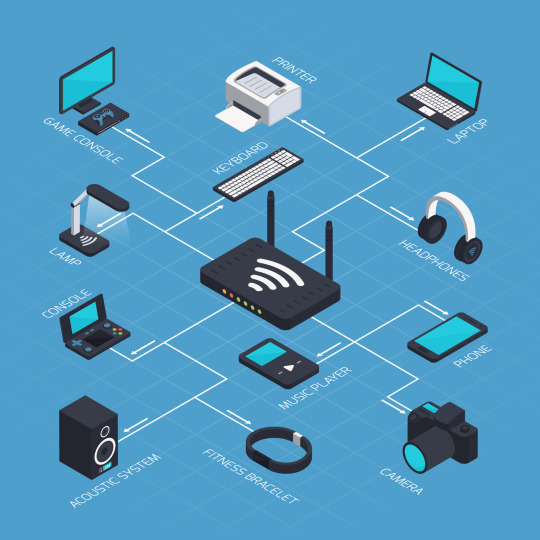
Benefits of Computer Networks
Resource Sharing:
Networks make things easy to share like files, printers, and software applications, reducing the need for duplicate resources.
Seamless Communication:
With instant messaging, email, and video calls, networks ensure quick and authentic communication, no matter how far away are you.
Cost Savings:
By collecting resources and data storage, networks cut down on operational costs, especially for businesses.
Anywhere Access:
Modern networks allow you to access data from any connected device, whether you are at home or on the go.
Scalability:
As your needs develop networks will grow too, by supporting more users and devices over time.
Increased Productivity:
It reduces delays in automated processes and real-time data sharing and streamlines workflows, boosting efficiency.
Why Computer Network Skills Are Crucial for Entry-Level Corporate Roles
For those starting their careers, knowledge of computer networks can be a significant asset:
Essential for Office Environments:
In today's world, most workplaces rely on LANs and WANs for everyday operations. Knowing how these networks function allows employees to balance basic connectivity issues, making sure work stays on track without interruptions.
Supports Collaboration Tools:
Corporate tools like Microsoft Teams, Slack, and cloud-based systems depend heavily on networks. Understanding their underlying principles helps entry-level employees adapt quickly to these platforms.
Enhances Problem-Solving Skills:
Entry-level employees with networking knowledge can help IT, teams, by identifying and resolving minor network problems, exhibiting their value early on.
Boosts Technical Proficiency:
Networking skills indicate a candidate’s technical potential, giving them a head start in industries where tech literacy is required.
Prepares for Future Roles:
As technology makes progress, advanced networking concepts like cybersecurity and IoT integration are becoming integral. Early experience with networks lays a strong beginning for growth in these areas.
Challenges of Computer Networks
Security Risks: Networks are at risk of threats like hacking and malware, requiring robust security measures.
Cost of Setup: High-quality network infrastructure can be costly to install and maintain.
Technical Complexity: Balancing and managing networks frequently need specialized skills.
Conclusion
Computer networks are essential in today’s globalized world. From pushing day-to-day operations in businesses to enabling global communication, their impact is wide-ranging. For aspiring professionals, having computer networking skills can provide a competitive advantage, especially in entry-level corporate roles where technical knowledge is highly valued. By understanding the basics of networks and their benefits, individuals, and organizations can unlock new levels of productiveness and innovation.
I mastered Computer Network at NIPSTec, which is renowned as the best Computer Network institute in Delhi. If you're in Delhi and looking for top-notch training in computer networks, visit NIPSTec for expert guidance and practical learning.
2 notes
·
View notes
Text
So, after watching some dbh videos i had another idea for my “How I think shit works” list. This time i’ll be talking about how I think interfacing works in DBH, the difference between a proper interface and an interaction and the difference between some models.
⚠️ Just be aware i won't be giving any electronics, computing networks, internet or cyber security lessons here cuz i ain't a teacher, i'm just a dude making some theories. Also, this ain't a detailed stuff it's just guessing. Don't take it seriously it's just me playing with names. (and don't mind my english and lack of proper vocabulary)
▷ Establishing Connection
I gonna separate things in 4 main topics: "Points of interest/connection", "Direct interfacing", "No-Touch Transmission" and "External Interaction".
⚠️ Just to be clear every action kinda got some data exchange by default irl but to make things sound more cool i gonna use different terms.
→ Points of interest (connection)
Points where we can estabilish a connection/interaction
(→ ← for data flow; ←receiving, →sending)
Hands (mostly) (←→)
Most known areas of contact are the palm and fingertips. But it's possible receive connection thru the back of the hand.
Forearms (←)
I got the slight impression there's some read action related to the thirium energy levels in the wrist. I simply don't know if it's true or the game "doing things the human way" again.
Upperarms (←)
Usually closer to where the armband is.
Shoulders (←)
Trapezius (headcanon) (←)
Head/Internal head component-transmissor (←→)
Probably where the LED is. Maybe the LED is some sorta tracker? I don't know. I'll let to your imagination. But for sure there's a transmissor in this same side of the head. I mean probably.
→ Direct interfacing
Happens when using the hand into another another point of connection. The android skin must be made of something that blocks any type of direct connection, so the classic way of knowing we got an interface is by looking if the skin is being retracted. We also got a glowing light.
Clothes, for some reason, won't interrupt or block the connection but the skin probably still retract under it. Does it make the connection speed "slower"? I don't know. Practically doesn't seem to have any difference, unless we got a material that can block or isolate these frequencies.
When we talking about direct interface, we got basically 3 types:
(A, B for actors; → ← for data flow; red for active actor (mostly), blue for passive actor (mostly); green for mutual/both)
Mutual data exchange (A←→B or A→←B)
Both sides are sending and receiving data at the same time. The most clear example is "brain" connection, a shared space where 2 brains basically become one. What happens in A runs in B at the same time.
Average Send and Receive (not forced A→B or A←B)
When a connection is estabilished, one actor will send their own data to another actor, but this second actor won't send any data back to the first actor or let 'em own stuff be read. Another case is one actor doing the action of extract data from another actor without letting 'em own stuff be read. One is a Sender->, the other one is a Receiver←, also works if it's read only (accessing memories, for example). A classic example would be a information transfer or a reader pad of sorts (what's the mf name?).
I know the definition of sender and receiver can become confusing when we got an active actor receiving information but ain't the passive actor that is sending, is the active one that is pulling things, know what i mean? Don't mind me.
System breaching (forced A→B or A←B)
We have an actor always accessing another system without permission, usually trying to inject or extract data. Sometimes is the case it's just a system read action, but if ain't "consensual" i consider a breaching for obvious reasons. By consensual i mean more like bypassing authorization and security protocols, usually androids can't invade each other systems like this. Usually.
→ "No-Touch" Transmission
I theorize we can have a transmission when 2+ devices are in the same network or one actor can access others network (as unknown entity). In this case we can have all the same points from before (Send/receive, Breaching and Exchange) without any “physical” contact.
→ External Interaction
The name already tell ya all. I guess the main difference from a direct interface (visually) would be the way the skin of the actor(→ or ←) won't retract. They ain't exactly interacting with the system internally, there's no data flow.
━━━━━━
▷ Examples
U must be asking...
"when did all this happen in DBH? Ain't you just overthinking again?"
If for some reason find and read this i want let u know u are totally correct. Every name here is a headcanon, but the action itself happens in canon. To help illustrating my ideas i gonna drop some screenshots with a summary of what i think it is, if needed ofc.
→ Direct Interface - Mutual data exchange


→ Direct Interface - System breaching
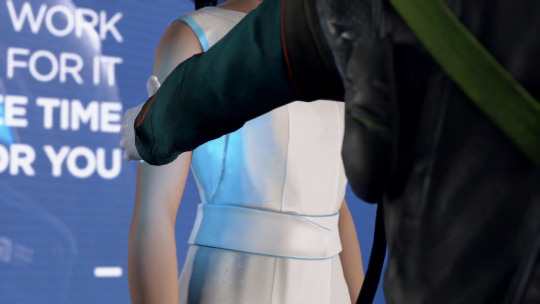
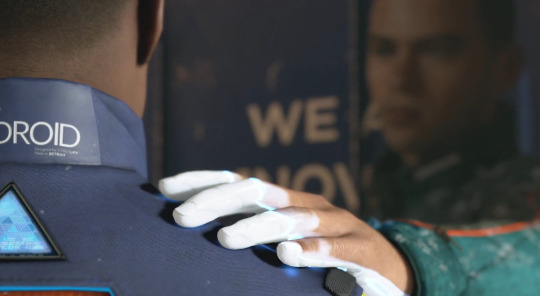

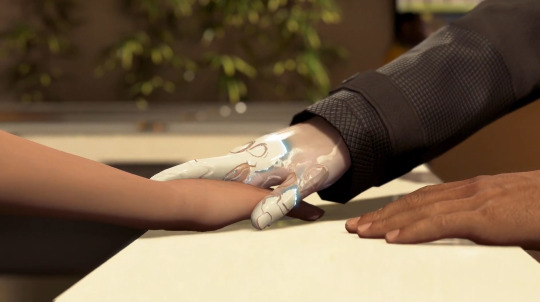
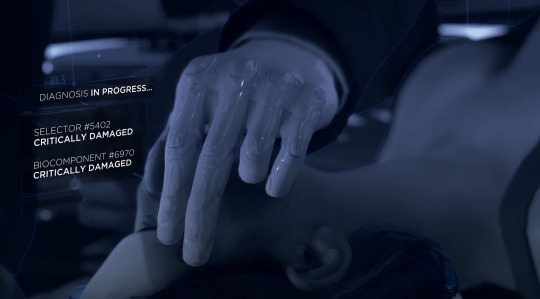

Explaining the last 2 ones:
In the first one is a internal system diagnosis and the second one i have my doubts. Idk if he's trying to access her memory, if he's trying to access her energy levels or trying to force a start enough to retain relevant data. And like i said in "System breaching" i'll be considering a breaching if ain't "consensual" even if it's a read only action - she's literally shutdown.
→ Direct Interface - Average Send and Receive


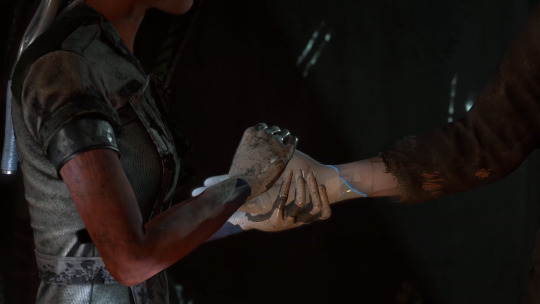

Chotto matte, Marcus. What Connor unlocking the door got to do with it?
Well, he's sending his info to the pad so it recognizes him and unlock the door OR the pad sensor is pulling his info to make a match with dbs and unlock the door. U choose - actually is both at the same time but we won't talk about that 🤫 remember the ⚠️
→ No-Touch Transmission - System breaching || Average Send and Receive

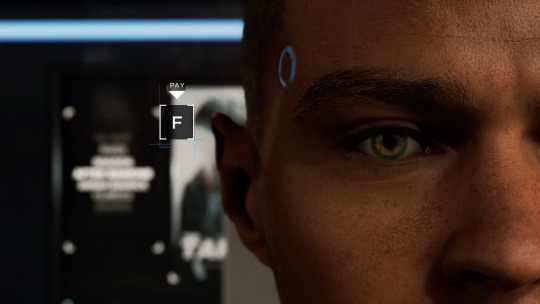
You are probably asking yourself WTF? but i'll try to explain what i think:
The first one i interpret as Markus finding and accessing the network this android is connected and finding her "device", then breaching it, having access into, well, her. How? Probably scan and help of some network breaching tools.
The second one already exists nowadays and i know i didn't explained further but in summary: when u make a virtual payment via internet, even if from different "devices" and "nets" they kinda come together in another one to make a succesful transaction. And i believe most of mfs in this universe use the same bank and the same type of connection, after all...androids got a default system and the internet is only one.
→ External Interaction

Listen, i know what u gonna say. "It's an interface, Marcus". No, ain't a interface. First cuz Connor ain't pushing or pulling any data outta the Traci system. Second cuz what did i say about direct interfaces? Hands without skin. This one seems like a hardware action to me, know what i mean? Does Connor got any kinda tool in his hand to make the Traci's skin retract? Yes. Is it an interface action? No. It's an external interaction? Yes, in my opinion ofc. Would be the same if a technician had a tool to make the skin retract/disperse.
━━━━━━━
▷ Last babbling
There will be conflicts in all this and some theories may not work sometimes, just saying. I gonna list some few thoughts i had, mostly doubts:
"Deviant" AP700s can breach other AP700s or maybe ain't exactly breaching but they got a compatibility that makes 'em system recognize another AP700 request as non-threatening automatically;
A similar thing happen with the RK800 but more complex. They're so compatible they can even swap bodies without major "resistance" from the receiver side even if it's a breaching;
RKs are the only models that can breach any android, break 'em handler system and even give 'em new orders (also by transmission);
Common models can't exactly "convert" other models but for some reason they can breach other low-security devices if they ain't authorized to use it;
I assume Markus can scan and breach other androids remotely (convert) within 5~10m radius without major conflicts;
Android exchanging information via transmission is the most realistic way of interface in a "wireless" world like DBH but, to illustrate some things so we can understand better, in the game we got the direct interface. Unless the direct one is more efficient cuz it's direct and got a weight feeling;
Markus and Connor interface speed may be faster than an average model (meaning they take less time to breach, extract and transfer data). Maybe an AP700 is faster too?;
I don't have any details about the security measures in case of breachings in common models. Doesn't seem like they can fight an forced interface at all xD;
You probably noticed androids got multiple points of connection but depending on the meaning of the interface X place is more used than Z. Don't ask me why 💀
It's unlikely a direct interface can start using the lower part of the body (lower torso and legs);
When in a direct interface not always the receiver will have 'em skin retracted. I think it probably happens in breachings, where the receiver system ain't acknowledging the action as a proper and authorized interface;
It's likely the only parts of the body where the skin retracts during interface are the arms and maybe the LED area (you know exactly what I'm talking about and why);
#dbh#detroit become human#i'll probably edit it 300 times#dbh: how i think shit works#markus rk200#kara ax400#connor rk800
34 notes
·
View notes
Text
The Critical Role of Structured Cabling in Today's Digital World
In today’s fast-paced, technology-driven world, structured cabling plays a vital role in keeping businesses and homes connected. Whether it’s for data, voice, or video, a well-organized cabling system is the backbone of any communication network. With the increasing demand for high-speed, reliable connections, structured cabling has become more important than ever before. This article explores the significance of structured cabling, how it supports modern technology, and why it’s essential for both businesses and residential setups.

What is Structured Cabling?
Structured cabling refers to the standardized approach used to organize and install cables that carry data and communication signals. It’s a complete system of cabling and associated hardware, designed to provide a comprehensive telecommunications infrastructure.
This type of cabling supports a wide range of applications, including internet, phone systems, and video conferencing. By creating a structured layout, this system ensures efficient data flow and makes it easier to manage upgrades, changes, or troubleshooting.
Structured cabling systems are divided into six main components: entrance facilities, backbone cabling, horizontal cabling, telecommunications rooms, work area components, and equipment rooms. These components work together to create a seamless communication network.
The Benefits of Structured Cabling
The primary benefit of structured cabling is its ability to support high-performance networks. It’s designed to handle large volumes of data, ensuring that businesses can operate without interruption.
Additionally, structured cabling offers flexibility. It allows for the easy addition of new devices and systems without needing to overhaul the entire infrastructure. This scalability is especially important in today’s world, where technology is constantly evolving.
Structured cabling also enhances efficiency. It reduces the risk of downtime by providing a reliable, organized system that is easy to manage. Troubleshooting and maintenance become simpler, saving businesses time and resources.
Finally, structured cabling offers future-proofing. With this type of system, businesses can stay ahead of technological advancements, as it supports higher data transfer rates and new technologies like 5G and IoT.
How Structured Cabling Supports Modern Technology
As technology advances, the need for fast and reliable data transmission grows. Structured cabling supports a wide range of modern technologies that are critical for businesses and homes.
For businesses, having a robust structured cabling system is essential for running daily operations. From cloud computing to video conferencing, every aspect of a company’s communication relies on a solid network foundation. Employees need to access data quickly, collaborate in real-time, and use cloud-based software efficiently. Without structured cabling, these tasks become more difficult and less reliable.
In homes, structured cabling ensures that entertainment systems, smart devices, and internet connections run smoothly. As smart home technology becomes more prevalent, having a reliable cabling system in place is key to integrating these devices and maintaining their performance.
The Importance of Structured Cabling in Data Centers
Data centers are the heart of any company’s IT infrastructure, and structured cabling is critical to their success. These facilities store vast amounts of data and support essential business functions like email, file storage, and cloud services.
A structured cabling system in a data center enables efficient communication between servers, storage systems, and network devices. It allows data to move quickly and reliably across the network. Without it, data centers would struggle with congestion, leading to slower performance and increased downtime.
The efficiency and scalability of structured cabling make it ideal for data centers, where the demand for faster data transmission is always growing. With the rise of cloud computing, IoT, and big data, structured cabling has become more critical than ever in keeping data centers running at peak performance.
Why Structured Cabling is Crucial for Future Growth
As technology continues to evolve, businesses need to be prepared for future growth. Structured cabling provides the foundation for that growth by offering a scalable, flexible solution that can adapt to new technologies.
One of the most significant trends in technology today is the rise of the Internet of Things (IoT). IoT devices, such as smart sensors and connected appliances, rely on strong network connections to function properly. A structured cabling system ensures that these devices can communicate with each other seamlessly, supporting the expanding ecosystem of connected technology.
Additionally, structured cabling supports faster internet speeds and higher bandwidth, both of which are essential for businesses and homes. With the rise of 5G and other advanced technologies, having a robust cabling infrastructure will be crucial for staying competitive and keeping up with the demands of modern technology.
Working with Professionals for Installation
Installing structured cabling requires expertise, as it’s a complex process that involves designing a layout, selecting the right cables, and ensuring everything is properly organized. This is where working with professionals becomes important.
For businesses or homeowners searching for networking services near me, it's essential to work with a contractor who understands the unique needs of each project. Whether upgrading an existing system or installing new cabling from scratch, experienced professionals can design and implement a system that ensures optimal performance.
Professional installation not only guarantees that the system is set up correctly, but also minimizes the risk of future issues. With their expertise, they can ensure that your structured cabling system is scalable, efficient, and capable of supporting future technologies.
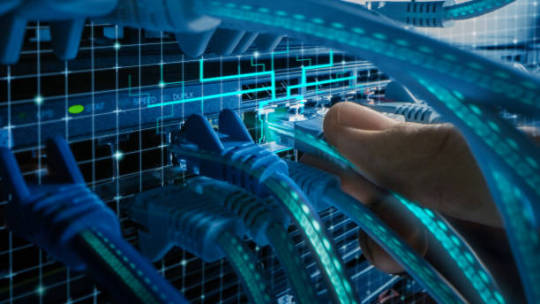
Conclusion
Structured cabling is the backbone of today’s digital world, providing the reliable infrastructure needed for businesses and homes to stay connected. It supports the rapid growth of modern technologies like cloud computing, IoT, and 5G, while also offering flexibility and scalability for future advancements.
For anyone looking to enhance their network performance, investing in structured cabling is a smart choice. It’s an investment in efficiency, reliability, and the future of technology. By working with professionals who understand the importance of structured cabling, you can ensure that your communication infrastructure is ready to meet the demands of today and tomorrow.
2 notes
·
View notes
Text
11. "Well that worked out great"
Fandom - Pathfinder: Wrath of the Righteous Content warnings - none [A/N: a little follow up to this previous entry]
Power resonates between Ollerus’s fingertips as she prepares her spell, contemplating the objects on her desk. A blank book, a circlet, and a small glowing disc sit atop a small circular array she’s laid out; the arcane inscriptions written around its circumference begin to shimmer and dance as her magic takes hold.
Alien, ethereal runes lift from the circlet and the disc; they rise in delicate ribbons before feeding into the nearby book. Rippling text begin appearing across its blank pages, and they rapidly turn as each page fills.
Several minutes pass before the spell runs its course. As the power of her arcane inscription die down, the sorcerer peers down at the book. It emits a faint magical aura now, its previously nondescript contents now an aurora of magical runes consisting of a language recognizable by Golarion standards mixed with an otherworldly script that likely originated from a completely different plane.
The book suddenly twitches, and Ollerus waits with bated breath as its pages light up. A familiar, monotone voice speaks, tinny and faint.
“Beginning awakening cycle. Retrieving memory banks,” the voice of Hundred-Face announces, much to her glee. The book seems to shudder, and while it ironically has no face this time, she has to imagine how confused—or whatever is its equivalent—it must be when it realizes the situation it’s in.
“Good morning, Hundred-Face,” she greets in a sickly sweet voice. “It’s been a while. How are you finding your new vessel?”
“You.” Its recognition is evident. The book twitches again. “This vessel is not of flesh and blood like the last, nor is it composed of other suitable inorganic material. What...have you done?”
Ollerus grins in smug triumph at how close it sounds to true astonishment. Data retrieved from the strange device within the Blackwater settlement made it all possible, allowing her to preserve Hundred-Face as an entity even in the face of physical death. A Scribe’s Binding spell facilitated the transfer to the new “vessel”, giving it its new lease on life.
The Hundred-Face book falls silent after she explains, before saying, “This vessel feels inadequate in many ways even when compared to standard mortal forms. I fail to see any logical reasoning behind this choice.”
“Are you sure? What about if I do this?”
Without any warning she grabs the book and tosses it in the air. It makes a sound akin to what she could only describe as a yelp, and before it hits the floor, it suddenly lurches midair into an upright position. Hundred-Face hovers several feet above the floor, wobbling unsteadily as it finds its bearings.
“Well, that worked out great, now didn’t it?” Ollerus speaks out loud to herself, pleased with the good results to her little experiment.
“Why did you do this?”
She doesn’t answer right away, instead choosing to examine the small disc that made up one of her spell components. How many times in the past had she pored over data like this, long before she’d come to Mendev? Memories of a past life came fluttering back, of countless nights spent with her nose in books, locked away in solitude in a magical laboratory. Back when she cared for little besides the rush of new discoveries, the drive to evolve and improve, to push the limits of what was and mold reality to her wishes, regardless of the cost others would have to pay.
She shouldn’t have done this, in all honesty. It would have been better to leave old habits behind, like she promised herself. She swore she would be different, that she would be better.
Yet something about hearing Hundred-Face’s voice for the first time rubbed her the wrong way; she wanted to grind its face into the dirt and take its precious device and bend it to her own whims. Twist it until it was almost recognizable, until she made it ten times better than the original just so she could throw it into someone’s face that she could.
Ollerus isn’t entirely sure how she was able to resist the temptation. The potent combination of spite and ambition have served her well in the past, and surely no one would fault her if it inadvertently provided an overall benefit to the crusade along the way.
Perhaps being knight commander has truly softened her. Maybe she’s just lost her edge. Regardless, a floating book isn’t entitled to the entirety of her motives.
“You said before that you wanted to create the perfect tools for an army. Well, here I am, granting your wish. You are now my tool, to assist and serve me both in battle and outside of it.” With a twitch of her finger, the book flies back into her hand. “You’ve been infused with all the information I could extract from that device and then some, and I’ve included functionality for you to record and preserve future incoming data. I’ve also given you the ability to cast certain spells, though I’ll still need to confirm that through additional testing.”
She smiles wickedly, clearly enjoying herself. “I would have also liked to scrap the original personality you possessed given I proved how defective it was in our previous battle but alas, creating a new one would have taken more time and energy that I’m not willing to spare. But don’t worry, I balanced it out by optimizing your analytical capabilities to improve your problem solving skills and ability to assess risk since I noticed they were quite suboptimal before.”
The first part is a lie, since she’s reprogrammed it to act exclusively on her own orders and judgment, but there’s no harm in throwing a few more digs, is there? The sorcerer is positively gleeful as she beholds her new toy, who can do nothing but act according to her wishes.
“Ah, Hundred-Face, this will be fun. I’m sure this is the start of a beautiful relationship.”
#fictober24#pathfinder: wrath of the righteous#pathfinder wrath of the righteous#wotr commander#oc: ollerus#GET GRIMOIRE'D BITCH#not even going to hide it the nier replicant inspo was strong in this one#me: i would love to have a grimoire weiss of my own so an oc gets one#*completely ignores the absolutely horrible circumstances that led to the grimoires' creation*
2 notes
·
View notes
Text
Top Technical Skills for Electronics Engineer Resume in 2024
Electronics and Communication Engineering (ECE) offers a wide array of career opportunities due to its interdisciplinary nature, combining principles from electronics, telecommunications, and computer science. Here are the top 15 career options for graduates in this field:
1. Telecom Engineer
Telecom engineers design and manage communication systems, including optical fibers, microwave transmission, and IP networks. They analyze existing technologies and develop new solutions to enhance communication reliability and efficiency.
2. R&D Software Engineer
These engineers focus on creating and testing new software products. They play a crucial role in research and development, working on automation and mechanical controls to improve software systems across various industries.
3. Software Analyst
Software analysts design, develop, and test software applications, ensuring they meet user needs. They act as a bridge between developers and users, managing software updates and enhancing user experience.
4. Electronic Design Engineer
Electronic design engineers create electronic circuits and devices tailored to specific requirements. They work on projects ranging from consumer electronics to complex communication systems.
5. Embedded Systems Engineer
Embedded systems engineers develop software for embedded systems found in various devices like appliances, medical equipment, and automotive systems. This role requires proficiency in both hardware and software development.
6. Network Engineer
Network engineers design, implement, and manage computer networks within organizations. They ensure network security and optimize performance for efficient data transfer.
7. Service Engineer
Service engineers maintain and repair electronic equipment used in various industries. Their work ensures that systems operate smoothly, minimizing downtime for businesses.
8. Technical Sales Engineer
In this role, engineers leverage their technical knowledge to sell complex electronic products or services. They often work closely with clients to understand their needs and provide tailored solutions.
9. Quality Assurance Engineer
Quality assurance engineers focus on testing products to ensure they meet required standards before they are released to the market. This role involves developing testing protocols and analyzing results to improve product quality.
10. Systems Engineer
Systems engineers oversee the integration of various subsystems into a complete system, ensuring all components work together effectively. This role is critical in projects involving complex electronic systems.
11. Electronics Technician
Electronics technicians assist in the design, development, and testing of electronic equipment. They often work under the supervision of engineers to troubleshoot issues and perform repairs.
12. Data Analyst
Data analysts in the ECE field focus on interpreting data related to electronic systems or communications networks. They use statistical tools to provide insights that can improve system performance or user experience.
13. Technical Director
Technical directors oversee engineering projects from conception through execution, ensuring technical feasibility while managing teams of engineers. They play a pivotal role in strategic planning within organizations.
14. Chief Technical Officer (CTO)
As a senior executive, the CTO is responsible for overseeing the technological direction of a company. This role involves strategic decision-making regarding technology investments and innovations.
15. Research Scientist
Research scientists in ECE focus on advancing knowledge in areas like telecommunications or signal processing through experimental research or theoretical analysis. This role often requires advanced degrees (MTech or PhD) for positions in academia or specialized industries.
Conclusion
Arya College of Engineering & I.T. is the Best Engineering College in Jaipur that gives career landscape for Electronics and Communication Engineers is diverse and continually evolving due to rapid technological advancements. Graduates can choose from various roles across multiple sectors including telecommunications, IT, manufacturing, aerospace, healthcare, and more, making ECE a promising field for aspiring professionals seeking dynamic career paths.
2 notes
·
View notes
Text
Crypto trading mobile app
Designing a Crypto Trading Mobile App involves a balance of usability, security, and aesthetic appeal, tailored to meet the needs of a fast-paced, data-driven audience. Below is an overview of key components and considerations to craft a seamless and user-centric experience for crypto traders.
Key Elements of a Crypto Trading Mobile App Design
1. Intuitive Onboarding
First Impressions: The onboarding process should be simple, guiding users smoothly from downloading the app to making their first trade.
Account Creation: Offer multiple sign-up options (email, phone number, Google/Apple login) and include KYC (Know Your Customer) verification seamlessly.
Interactive Tutorials: For new traders, provide interactive walkthroughs to explain key features like trading pairs, order placement, and wallet setup.
2. Dashboard & Home Screen
Clean Layout: Display an overview of the user's portfolio, including current balances, market trends, and quick access to popular trading pairs.
Market Overview: Real-time market data should be clearly visible. Include options for users to view coin performance, historical charts, and news snippets.
Customization: Let users customize their dashboard by adding favorite assets or widgets like price alerts, trading volumes, and news feeds.
3. Trading Interface
Simple vs. Advanced Modes: Provide two versions of the trading interface. A simple mode for beginners with basic buy/sell options, and an advanced mode with tools like limit orders, stop losses, and technical indicators.
Charting Tools: Integrate interactive, real-time charts powered by TradingView or similar APIs, allowing users to analyze market movements with tools like candlestick patterns, RSI, and moving averages.
Order Placement: Streamline the process of placing market, limit, and stop orders. Use clear buttons and a concise form layout to minimize errors.
Real-Time Data: Update market prices, balances, and order statuses in real-time. Include a status bar that shows successful or pending trades.
4. Wallet & Portfolio Management
Asset Overview: Provide an easy-to-read portfolio page where users can view all their holdings, including balances, performance (gains/losses), and allocation percentages.
Multi-Currency Support: Display a comprehensive list of supported cryptocurrencies. Enable users to transfer between wallets, send/receive assets, and generate QR codes for transactions.
Transaction History: Offer a detailed transaction history, including dates, amounts, and transaction IDs for transparency and record-keeping.
5. Security Features
Biometric Authentication: Use fingerprint, facial recognition, or PIN codes for secure logins and transaction confirmations.
Two-Factor Authentication (2FA): Strong security protocols like 2FA with Google Authenticator or SMS verification should be mandatory for withdrawals and sensitive actions.
Push Notifications for Security Alerts: Keep users informed about logins from new devices, suspicious activities, or price movements via push notifications.
6. User-Friendly Navigation
Bottom Navigation Bar: Include key sections like Home, Markets, Wallet, Trade, and Settings. The icons should be simple, recognizable, and easily accessible with one hand.
Search Bar: A prominent search feature to quickly locate specific coins, trading pairs, or help topics.
7. Analytics & Insights
Market Trends: Display comprehensive analytics including top gainers, losers, and market sentiment indicators.
Push Alerts for Price Movements: Offer customizable price alert notifications to help users react quickly to market changes.
Educational Content: Include sections with tips on technical analysis, crypto market basics, or new coin listings.
8. Social and Community Features
Live Chat: Provide a feature for users to chat with customer support or engage with other traders in a community setting.
News Feed: Integrate crypto news from trusted sources to keep users updated with the latest market-moving events.
9. Light and Dark Mode
Themes: Offer both light and dark mode to cater to users who trade at different times of day. The dark mode is especially important for night traders to reduce eye strain.
10. Settings and Customization
Personalization Options: Allow users to choose preferred currencies, set trading limits, and configure alerts based on their personal preferences.
Language and Regional Settings: Provide multilingual support and regional settings for global users.
Visual Design Considerations
Modern, Minimalist Design: A clean, minimal UI is essential for avoiding clutter, especially when dealing with complex data like market trends and charts.
Color Scheme: Use a professional color palette with accents for call-to-action buttons. Green and red are typically used for indicating gains and losses, respectively.
Animations & Micro-interactions: Subtle animations can enhance the experience by providing feedback on button presses or transitions between screens. However, keep these minimal to avoid slowing down performance.
Conclusion
Designing a crypto trading mobile app requires focusing on accessibility, performance, and security. By blending these elements with a modern, intuitive interface and robust features, your app can empower users to navigate the fast-paced world of crypto trading with confidence and ease.
#uxbridge#uxuidesign#ui ux development services#ux design services#ux research#ux tools#ui ux agency#ux#uxinspiration#ui ux development company#crypto#blockchain#defi#ethereum#altcoin#fintech
2 notes
·
View notes
Text
On Feb. 3, 2022, just three weeks before Russia invaded Ukraine, the Russian navy conducted mysterious exercises in a surprising location: off the Irish coast. Coincidentally, of course, the exercises took place directly above a point dense with trans-Atlantic data cables, three quarters of which pass near Ireland. These were not routine exercises, and Russia did not ask for permission to conduct them, but the incident exposed Ireland’s inability to deter attacks on waters within its exclusive economic zone.
Despite being an island, Ireland has never developed a defense commensurate with its wealth or importance to the global economy. Its navy has six small ships, and its air corps—not yet a full-fledged air force—has no fighter jets.
The Russian exercises demonstrated how critical Ireland has become to Europe’s economy, thus making it a target for Russian military harassment. Its role in international data transfer infrastructure places it at the center of the European strategic theater in a way it was not during the Cold War.
Given this new reality—and the fact that Ireland’s immigrant population today has strong ties to the countries most threatened by a revanchist Russia—Ireland needs a major rethink of its defense plans. But doing so will require letting go of certain ideas that have long governed how it conceives of its security.
Among European countries, Ireland has a rather unusual alignment. Though it has been politically allied with the United States since independence in 1921, Ireland declared military neutrality at the outbreak of World War II. Openly siding with the Allies would have risked both a German invasion and a British counterinvasion, neither of which the new state, free for just 18 years, could have hoped to repel. This specific neutrality eventually evolved during the Cold War into a broader pacifism that purported to position Ireland between the United States and the Soviet Union, notwithstanding the ironclad anti-communism of its Catholic population.
The idea that Ireland’s neutrality in World War II prevented it from joining a military alliance such as NATO eventually became conventional wisdom in Ireland. But this was a myth. Though Ireland did not join NATO, its reason was its dispute with the United Kingdom over control of Northern Ireland, not opposition to an anti-communist alliance. In fact, Ireland suggested a separate, binding defense treaty with the United States in 1949. In an exchange of letters with officials in Washington that year, the Irish government insisted that Ireland “has remained, to a greater extent than any other European State, immune from the spread of Communism. … [W]ith the general aim of the proposed Treaty, the Irish Government is in agreement.”
Though there was no tradition of not joining military alliances, Ireland eventually came to embrace the stance later. The principle that applied during World War II was resurrected during the Cold War to bolster Ireland’s legitimacy in diplomatic initiatives such as the Nuclear Nonproliferation Treaty and in U.N. peacekeeping missions between the 1960s and 1980s. Neutrality afforded Ireland significant soft power and allowed it to present itself as both European and anti-colonial.
Controversy returned a few decades later as the European Union started to develop a military component through the Treaty of Nice in 2001, followed in 2007 by the Treaty of Lisbon. In Ireland, opponents argued that adopting the treaties would commit Ireland to joining a European military alliance. To defray such concerns, and to ensure that it could ratify the 2007 treaty, Ireland secured an opt-out from a common European defense that allowed it to maintain a veto over the deployment of its own troops, even as the common defense denied EU members such a veto.
In addition to the opt-out, Ireland increased the political salience of a long-standing policy on force deployment that became known as the “triple lock,” which prevents the deployment of the Irish army overseas unless three conditions are satisfied: a U.N. Security Council or General Assembly resolution, a formal decision by the Irish government, and a resolution by the lower house of Ireland’s parliament. It is, however, a narrowly drawn restriction, and it doesn’t prevent Ireland from joining common procurement projects, such as the EU’s PESCO military cooperation initiative, or relieve it from mutual defense obligations.
Today, Ireland remains one of only four EU countries that are not members of NATO. Though its neighbors have tolerated Ireland’s nonmembership, they are now much more concerned with the country’s practical inability to defend itself against harassment from Russia. If NATO membership remains off the political agenda for the moment, changes in Ireland’s deployment policy and defense spending are afoot.
New legislation is planned to remove the U.N. Security Council requirement because Ireland doesn’t want Russia or China to be able to veto the deployment of its forces. Proposals to replace this part of the triple lock include only requiring the sign-off of a “regional organization,” which obviously includes the EU but could conceivably include NATO, too.
These changes in Irish posture, expected in the coming year, have not yet, however, been matched by sufficient changes in budgets.
Just before Russia invaded Ukraine, Ireland conducted a review of its defense posture that set out three levels of ambition, or LOAs, for its defense forces. The current government was only able to win support to adopt LOA 2, which would provide a defense budget of 1.5 billion euros ($1.6 billion) by 2028. This plan will raise defense expenditure to 0.56 percent of modified GNI—an indicator designed to take into account that Ireland is a base for many multinational headquarters and the international aircraft leasing industry, which distort GDP figures—up from 0.42 percent.
Ireland is due to hold elections on Nov. 29, and should opinion polls prove correct, Fine Gael, the party most in favor of defense reform, is likely to win, though it will need support from current partner Fianna Fail and possibly also the Green Party for a parliamentary majority. Such a government will face pressure because of the more dangerous international situation, as well as from allies who feel that wealthy Ireland should make a greater contribution to the defense of an economic system that produces this wealth, to increase the country’s defense effort. This would prompt Ireland to order combat jets and increase the navy’s size from six to 12 ships. It would also increase the defense budget to 3 billion euros ($3.2 billion) per year, or 1.13 percent of modified GNI. This was what the 2022 review assessed as the minimum required for Ireland to achieve LOA 3 and maintain a full-spectrum capability to defend its coastal waters, offshore wind energy potential, and trans-Atlantic cables from sabotage. Ireland’s defense posture reviews and related documents rarely mention likely enemies by name, but a large, cold one on the Eurasian continent was undoubtedly on their writers’ minds.
Yet even these plans have now become outdated following Russia’s full-scale invasion of Ukraine. The next government must consider what an LOA 4 would look like: sufficient to provide full-spectrum defense capabilities appropriate to a small maritime country and to contribute to common European defense and security.
To understand what a further increase could achieve, 2 percent of modified GNI corresponds to a budget of 5.3 billion euros ($5.6 billion) a year, nearly the same as Finland’s military budget (and around a fifth of Ireland’s projected budget surplus this year).
Ireland’s defense needs are, naturally, very different from those of Finland, which has a long land border with Russia. Priority should be given to maritime defense tasks and equipment that can be of use both for protecting European seas as well as Ireland’s own, including anti-submarine warfare and modern air defense, which Ireland doesn’t currently possess. The Russia-Ukraine war has shown the increasing importance of uncrewed systems in naval warfare, including submersibles and sea drones, as well as uncrewed aircraft, essential for protecting renewable energy infrastructure.
Given Ireland’s highly competitive labor market (the starting annual salary for a junior officer is around 50,000 euros, or about $53,000), investment in automation of military systems appears necessary for economic reasons, too. In the longer term, Ireland might even think of cooperating in the United Kingdom’s Type 83 destroyer program, a powerful new surface ship able to defend against submarine and air attack. If the ships were built in Belfast—now that the Good Friday Agreement has settled the conflict in Northern Ireland, unlike in 1949—that would allow an Irish one to become a symbol of U.K.-Irish cooperation.
Adopting such a defense policy will, however, require Ireland to convince its citizens with a new political argument: its role in European security. During the Cold War, the combination of military nonalignment and political embedding in the Western world made sense for a relatively poor country still under heavy British influence. But that time has passed. If 20th-century Ireland was principally focused on the English-speaking world, 21st-century Ireland is now decidedly more European, including its population. Just as Ireland’s own freedom was helped by its diaspora in the United States, so it should commit to the freedom of East-Central Europe, so much of whose diaspora now lives in Ireland. Its defense posture and budget should reflect this new, European reality.
3 notes
·
View notes